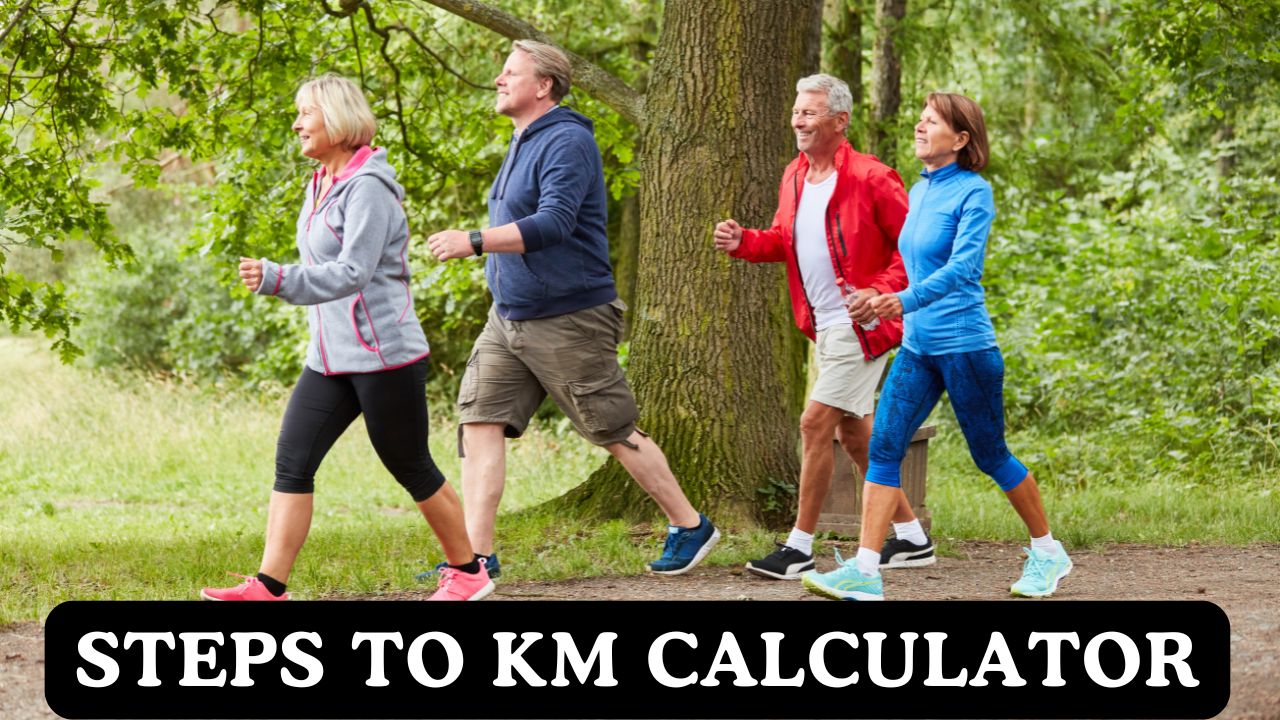Steps to Kilometers Calculator
Convert your walking steps to kilometers using personalized stride calculations. Track your daily distance goals with precision and improve your fitness journey.

How Many Steps Equal One Kilometer?
The number of steps in a kilometer depends on your individual stride length, which varies based on height, gender, and walking style. On average, most people take between 1,250-1,550 steps per kilometer. However, this can range from 1,120 steps for taller individuals to 1,680 steps for shorter people. Our calculator uses scientifically validated formulas to provide personalized conversions based on your specific measurements, ensuring more accurate distance tracking than generic estimates.
Scientific Stride Length Calculations
Modern fitness tracking relies on precise stride length formulas developed through biomechanical research. The most accurate method uses height-based calculations: Stride Length = Height × 0.415 for men and Height × 0.413 for women. This approach accounts for natural physiological differences and provides consistently reliable results. Regular walking exercise becomes more rewarding when you can accurately track your progress in kilometers rather than relying on step counts alone.
Why Kilometers Matter for Fitness Goals
Converting steps to kilometers provides concrete distance goals that are easier to visualize and achieve. While 10,000 steps might feel abstract, knowing you’ve walked 6.4 kilometers gives you a tangible sense of accomplishment. Distance-based goals also help with planning routes, comparing outdoor vs. indoor activities, and integrating walking into your daily routine. Home fitness routines can be enhanced by incorporating walking intervals measured in kilometers.
Personal Factors Affecting Step Length
Several factors influence your individual stride length beyond basic height and gender measurements. Walking speed naturally increases stride length, with brisk walking producing 5-10% longer strides than casual walking. Terrain also plays a role – uphill walking typically shortens stride length while downhill walking may lengthen it. Age can gradually reduce stride length over time, making periodic recalculation beneficial for maintaining accuracy in your fitness tracking efforts.
Steps to Kilometers Conversion Chart
Men – Steps to Kilometers by Height
| Height | Stride Length | Steps per KM | 5,000 Steps | 10,000 Steps | 15,000 Steps |
|---|---|---|---|---|---|
| 160 cm (5’3″) | 66.4 cm | 1,506 | 3.32 km | 6.64 km | 9.96 km |
| 170 cm (5’7″) | 70.6 cm | 1,417 | 3.53 km | 7.06 km | 10.59 km |
| 180 cm (5’11”) | 74.7 cm | 1,339 | 3.73 km | 7.47 km | 11.20 km |
| 190 cm (6’3″) | 78.9 cm | 1,268 | 3.94 km | 7.89 km | 11.83 km |
Women – Steps to Kilometers by Height
| Height | Stride Length | Steps per KM | 5,000 Steps | 10,000 Steps | 15,000 Steps |
|---|---|---|---|---|---|
| 150 cm (4’11”) | 62.0 cm | 1,613 | 3.10 km | 6.20 km | 9.30 km |
| 160 cm (5’3″) | 66.1 cm | 1,513 | 3.31 km | 6.61 km | 9.92 km |
| 170 cm (5’7″) | 70.2 cm | 1,424 | 3.51 km | 7.02 km | 10.53 km |
| 180 cm (5’11”) | 74.3 cm | 1,346 | 3.72 km | 7.43 km | 11.15 km |
Health Benefits of Daily Walking
Cardiovascular Health Improvements
Walking 6-8 kilometers daily (approximately 8,000-10,000 steps) significantly reduces the risk of heart disease, stroke, and high blood pressure. Research shows that regular walkers have 30-35% lower cardiovascular disease risk compared to sedentary individuals. The rhythmic nature of walking strengthens the heart muscle, improves circulation, and helps regulate blood pressure naturally. Leg strengthening exercises can complement your walking routine to build overall lower body endurance and power.
Weight Management and Metabolism
Converting steps to kilometers helps you understand the caloric impact of your daily activity. Walking one kilometer typically burns 30-50 calories depending on body weight and walking speed. A daily 5-kilometer walk (roughly 6,250-7,800 steps) can burn 150-250 calories, contributing significantly to weight management goals. Regular walking also boosts metabolism for hours after exercise, enhancing overall calorie burn throughout the day.
Mental Health and Cognitive Benefits
Distance-based walking goals provide mental health benefits beyond physical fitness. Walking 3-5 kilometers daily has been shown to reduce anxiety by 25% and depression symptoms by 20%. The goal-oriented nature of kilometer tracking gives a sense of accomplishment and progress. Proper recovery techniques between longer walks ensure consistent progress without overexertion, supporting both physical and mental well-being.
Bone Density and Joint Health
Weight-bearing exercise like walking strengthens bones and maintains joint mobility. Walking 4-6 kilometers daily provides optimal bone-loading stimulus without excessive joint stress. This distance range supports bone density maintenance in adults and can help prevent osteoporosis. The low-impact nature of walking makes it suitable for people with joint concerns while still providing significant health benefits.
Daily Step Goals and Distance Milestones
| Daily Steps | Distance (KM) | Distance (Miles) | Activity Level | Health Benefits | Walking Time |
|---|---|---|---|---|---|
| 3,000 | 1.9-2.4 km | 1.2-1.5 miles | Minimal | Basic movement | 20-30 min |
| 5,000 | 3.2-4.0 km | 2.0-2.5 miles | Low Active | Improved circulation | 40-50 min |
| 7,500 | 4.8-6.0 km | 3.0-3.7 miles | Moderately Active | Heart health benefits | 60-75 min |
| 10,000 | 6.4-8.0 km | 4.0-5.0 miles | Active | Weight management | 80-100 min |
| 12,500 | 8.0-10.0 km | 5.0-6.2 miles | Highly Active | Optimal fitness | 100-125 min |
| 15,000 | 9.6-12.0 km | 6.0-7.5 miles | Very Active | Athletic conditioning | 120-150 min |
Progressive Goal Setting
Start with achievable distance goals and gradually increase your daily walking target. Begin with 2-3 kilometers (2,500-4,000 steps) and add 0.5 kilometers weekly until reaching 6-8 kilometers daily. This progressive approach reduces injury risk and builds sustainable walking habits. Strength training for legs can support your walking goals by building the muscle endurance needed for longer distances.
Frequently Asked Questions
How accurate are steps to kilometers calculators?
Steps to kilometers calculators using height-based formulas are typically 85-95% accurate for most people. Individual variations in gait pattern, walking speed, and terrain can affect precision. For maximum accuracy, measure your actual stride length over a known distance like a 100-meter track. Our calculator accounts for gender differences and provides multiple calculation methods to suit different accuracy needs and walking styles.
Does walking speed affect my step count per kilometer?
Yes, walking speed affects stride length and therefore steps per kilometer. Faster walking typically results in longer strides, meaning fewer steps needed to cover a kilometer. The difference is usually 5-15% between casual walking (3-4 km/h) and brisk walking (5-6 km/h). Our calculator uses average walking speeds but consider using the conservative estimate if you walk very slowly or the height-based formula if you walk briskly.
How do I measure my stride length manually?
Method 1: Walk 20 steps at normal pace on a flat surface, measure the distance, then divide by 20.
Method 2: Walk a known distance (like 100 meters) counting your steps, then divide distance by step count.
Method 3: Use the height formula as a starting point: Height × 0.415 (men) or Height × 0.413 (women) for stride length in centimeters.
Should I focus on steps or kilometers for fitness goals?
Both metrics have value, but kilometers provide more meaningful fitness targets. Distance goals are easier to visualize, plan, and achieve progressively. Steps are useful for daily activity monitoring, while kilometers help with route planning and comparing different types of exercise. Bodyweight leg exercises can complement your walking routine when weather or time constraints limit outdoor kilometer goals.
How many calories do I burn per kilometer walked?
Calorie burn per kilometer depends on body weight, walking speed, and terrain. Generally:
• 50-60 kg: 30-40 calories per kilometer
• 60-70 kg: 40-50 calories per kilometer
• 70-80 kg: 50-60 calories per kilometer
• 80-90 kg: 60-70 calories per kilometer
Brisk walking and inclines increase calorie burn by 20-40% compared to level, moderate-pace walking.
Can I use this calculator for running steps?
This calculator is optimized for walking stride lengths. Running typically involves longer strides (20-40% longer than walking), so the results may underestimate running distances. For running, consider using a GPS watch or running-specific apps that account for the different biomechanics. However, the calculator can provide a conservative estimate if you adjust for longer running strides manually.
Walking Techniques for Better Distance Efficiency
Optimizing Your Walking Stride
Proper walking form can increase your natural stride length and improve efficiency. Keep your head up, shoulders relaxed, and arms swinging naturally. Land on your heel and roll through to your toes for optimal stride length. Avoid overstriding, which can decrease efficiency and increase injury risk. A natural, comfortable pace typically produces the most consistent stride length for accurate step-to-kilometer conversions.
Terrain Considerations
Different terrains affect your stride length and step count per kilometer. Flat pavement provides the most consistent results matching calculator predictions. Hills, sand, grass, and uneven surfaces typically shorten stride length, increasing steps per kilometer. Calf strengthening exercises can improve your ability to maintain consistent stride length across various terrains and walking conditions.
Building Walking Endurance
Gradually increase your daily walking distance by 10% weekly to build endurance safely. Start with distances that feel comfortable (2-3 km) and focus on consistency rather than speed. As your endurance improves, you’ll naturally develop a more efficient stride pattern. Foam rolling exercises can help maintain leg muscle flexibility and prevent tightness that might affect your natural stride length.
⚕️ Important Health Information
This steps to kilometers calculator provides educational estimates based on scientifically established stride length formulas. Individual results may vary due to personal gait patterns, walking speed, terrain, and physical conditions. The calorie estimates are approximations and should not be used as the sole basis for dietary decisions. Always consult with healthcare professionals before beginning new exercise programs, especially if you have pre-existing health conditions, joint problems, or cardiovascular concerns. The information provided is for general fitness guidance only and does not constitute medical advice. Start any new walking program gradually and listen to your body’s response.
Related
- Burpee Calories Burned Calculator
- Crunches Calories Burned Calculator
- Sit-Up Calories Burned
- Zumba Calories Burned Calculator
- Pull Up Calories Burned Calculator
- Push-Up Calories Burned Calculator
- Home Activities Calories Burned Calculator
- Exercise Calories Burned Calculator
- Running Calorie Calculator
- Walking Calorie Burned Calculator
References
- Herrmann, S. D., Willis, E. A., Ainsworth, B. E., Barreira, T. V., Hastert, M., Kracht, C. L., Schuna, J. M., Cai, Z., Quan, M., Tudor-Locke, C., Whitt-Glover, M. C., & Jacobs, D. R. (2023). 2024 Adult Compendium of Physical Activities: A third update of the energy costs of human activities. Journal of Sport and Health Science, 13(1), 6-12.
- Banach, M., Lewek, J., Surma, S., Penson, P. E., Sahebkar, A., Martin, S. S., Bajraktari, G., Henein, M. Y., Reiner, Ž., & Bytyçi, I. (2023). The association between daily step count and all-cause and cardiovascular mortality: A meta-analysis. European Journal of Preventive Cardiology, 30(18), 1975-1985.
- Choi BC, Pak AW, Choi JC, Choi EC. Achieving the daily step goal of 10,000 steps: the experience of a Canadian family attached to pedometers. Clin Invest Med. 2007;30(3):E108-13.

Manish is a NASM-certified fitness and nutrition coach with over 10 years of experience in weight lifting and fat loss fitness coaching. He specializes in gym-based training and has a lot of knowledge about exercise, lifting technique, biomechanics, and more.
Through “Fit Life Regime,” he generously shares the insights he’s gained over a decade in the field. His goal is to equip others with the knowledge to start their own fitness journey.
